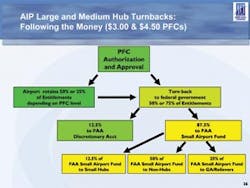ACI-NA: Unleash PFCs, Help AIP
While indications are that aviation funding levels in FY2007 will be in line with Vision 100 authorization, the Bush Administration continues to back major cuts and a new funding formula when the next reauthorization bill is created for FY08 and beyond. Should those cuts occur, most expect small airports to take the biggest hit. Stephen Van Beek, executive vice president, policy, for Airports Council International-North America, is spearheading a new information initiative that seeks to demonstrate that the fate of small airports and the Airport Improvement Program are directly tied to the passenger facility charge program, which generally benefits larger airports.
Explains Van Beek, “I think this is the most important reauthorization for maybe 25-30 years. Right now I’ve got projects going on PFCs, the trust fund, on bonds, on air traffic, and on privatization. On each of those we’ll be delivering a report back to our board. That really reflects the fact that all of these issues are important.”
Central to the ACI-NA position are the “turnback” dollars that large and medium hub airports must turn back — 50 to 75 percent — of their funding entitlements upon implementing a PFC, depending on the PFC level (see charts). Unleash the PFC caps and associated regulations, and larger airports benefit in a freer, business-oriented climate; a concurrent result, says ACI-NA, will be a larger small airport fund.
According to Van Beek, the association is preparing an information blitz to industry on their position.
Van Beek, in a recent interview with AIRPORT BUSINESS, outlined the association’s position on this and other aspects of the funding debate. Some edited excerpts:
- On whether funding mechanisms will prove adequate ...
“If things continue the way they are today, the trust fund is in very dire shape, indeed. We agreed with what Secretary [Norman] Mineta and Administrator [Marion] Blakey said, namely that we need to reform the trust fund.” - On the relationship between PFCs and AIP funding ...
“Any reduction overall in AIP ... will in fact bear disproportionately upon the smaller airports. Part of our goal as we move forward is to say, one way of shoring up in the long term AIP is by having a PFC increase, and having more of the so-called takedown from the PFC flow to both the smaller airports and also to the discretionary program, which is something both smaller and larger airports can benefit from.
“If you have both a strong PFC program and a strong AIP program, they complement each other, and they keep our constituency for reauthorization as broad and as deep as it can be.
“Traditionally PFCs have been thought of as a large airport program and AIP as a smaller airport program, and that somehow the two were distinct. While there is truth to the fact that PFCs on the capital side provides more money for larger airports, and AIP provides more money per passenger for smaller airports.” - On the debate to reform air traffic control, a major goal of the Air Transport Association ...
“There are really three sets of things that have to happen on ATC to really make progress on this bill. Number one is, FAA needs to define what their near-term plan on ATC is, what the benefits of that plan will be to the users, not just to FAA, and what the costs of the changes will be.
“Then, we need make sure that we treat the trust fund like a trust fund; that is, it is for long-term capital investments. If we get it and have a steady flow of income to air traffic control, that will help a great deal. And number three, if the users are going to pay for these improvements in air traffic control, how are we going to govern ATC and make management decisions. I don’t think ATA, nor ACI-NA, is going to sit back and say, we’re going to pay for everything and then the government’s going to decide how it’s spent.
“If you are going to migrate to a system that requires the users to pay more for a particular set of benefits, the users better be involved in defining what those benefits to the system can be. For airports, obviously, [it’s] the terminal environment and technologies that do things like increase capacity during inclement weather, particularly with closely spaced parallel runways. We need some confidence that when the FAA chooses its priorities for air traffic modernization, that our priorities are going to be a part of that process. - On ATA’s attempt to get more money from business aviation users ...
“We start with the assumption that the first goal is to make the trust fund stable and viable; it seems that some other folks are starting with the taxes. I think what we first should do is ask, do the taxes provide enough to meet the obligations and then let’s talk about what those should be. The business jet community is in a mode right now of knowing that their contribution will have to increase, but they hope to minimize that as much as possible.”
